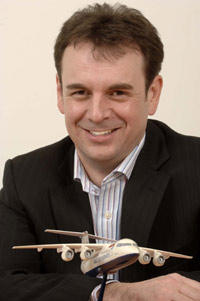Time, for BA CityFlyer managing director Peter Simpson, has flown over the past 12 months, but he is coping well with changes at the British Airways subsidiary.
Simpson joined Manx Airlines in 1985, and when Manx was acquired by BA and incorporated into its CitiExpress subsidiary he was appointed finance director of BA CitiExpress. He went through the change and re-branding of BA CitiExpress to BA Connect and then, a year ago, another change. BA Connect was sold to UK regional carrier Flybe but the 10-strong BAE Systems Avro RJ100 fleet and the London City routes, which BA has been growing over the last year, were excluded from the deal.
BA CityFlyer took over the London City operations from BA Connect and Peter Simpson was appointed to the role of managing director. His challenge was to continue the development growth plan at London City. A year on, Simpson says BA CityFlyer's operations have been "very satisfactory".
 "We managed to obtain an aircraft operating certificate for our operations within 72 days and since the first day of operations in March 2007, we have had a tremendous success at London City," he says. "We were striving to keep our unique selling point. We are sticking to our business model to fly point-to-point services and concentrate on business routes," he adds.
"We managed to obtain an aircraft operating certificate for our operations within 72 days and since the first day of operations in March 2007, we have had a tremendous success at London City," he says. "We were striving to keep our unique selling point. We are sticking to our business model to fly point-to-point services and concentrate on business routes," he adds.
BA CityFlyer has kept the BA Connect routes to Edinburgh, Frankfurt, and Madrid. But having missed out on the acquisition of VLM Airlines in December 2007, the carrier has had to grow internally. Since March this year it has added three routes to Glasgow, Nice and Zurich but ceased the flights to Milan Malpensa.
On 6 May, BA CityFlyer will launch three new routes to Amsterdam, Barcelona and Warsaw, increasing the British Airways network to nine destinations from London City airport.
Passenger numbers at London City reached a record high in 2007 of over 2.9 million, a 23% increase over 2006. The airport is investing some £30 million ($60 million) in constructing four new aircraft parking stands, and while the departure lounge is also being reconfigured.
Simpson says the changes at the airport will bring some relief to carriers for the summer period. He also envisages further expansion for BA CityFlyer. "We continue to look at opportunities to commence further new flights late this summer," he says.
Being six miles out of London makes London City an attractive airport for business passengers. According to Simpson, business passengers currently account for 80% of total passenger traffic, while leisure traffic makes up the remaining 20%.
"We are recognising leisure travellers out of City airport and my expectation is that business traffic will migrate to between 70% and 75% of total traffic," he says.
In line with its controlled growth, CityFlyer is adding two BAE Systems Avro RJ85s to its RJ100 fleet. "The RJ85s will provide a better blend of economics and performance on our longer routes, such as Madrid," says Simpson. The RJ85 will help CityFlyer to overcome the payload restriction in the summer at London City airport. "In the summer, we are limited to 60 passengers on some days," says Simpson.
The first aircraft will be in service early next month on the Madrid route, while the second aircraft will operate a combination of Zurich and Amsterdam routes out of London City.
The RJ85 additions are medium-term solutions though.British Airways is in the middle stages of evaluating potential replacements for the RJ100s operated at London City airport by CityFlyer.
Simpson says the carrier has two options for replacement now: extend the leases with BAE Systems Regional Aircraft for the whole fleet - BA CityFlyer has current leases through 2010 or replace the fleet with the Embraer 170/190-family aircraft. Simpson adds that CityFlyer is in discussions with Embraer over a potential order for new aircraft that will mix E-170s and E-190s. The request for proposal is for up to 15 firm aircraft.
BA has excluded from the study the Airbus A318, which the carrier is acquiring for its new all-business London City-New York operation, because it is too heavy and too uneconomical for short-haul flights out of the airport.
However, it is still in discussions with Bombardier for the Q400 model, which unlike the ATR 72-500 model is certified at London City airport. "SAS has operated the aircraft here and Luxair is now operating flights with the Q400," says Simpson. "The Q400 has a proven record and is a fast aircraft. At $100 a barrel, operating costs will be more efficient. The Q400 is a 78-seat aircraft and our configuration will be two classes with 72 seats. For our network, which typically involves one hour to an hour-and-a-half long flights, the Q400 will be as quick as a jet."
But with slot restrictions at London City, BA CityFlyer recognises the trade-off between lower operating costs of the turboprop and revenue generation per slot that is available from operating a 90 to 100-seat fleet. A final decision is expected by the summer.

Source: Airline Business



















